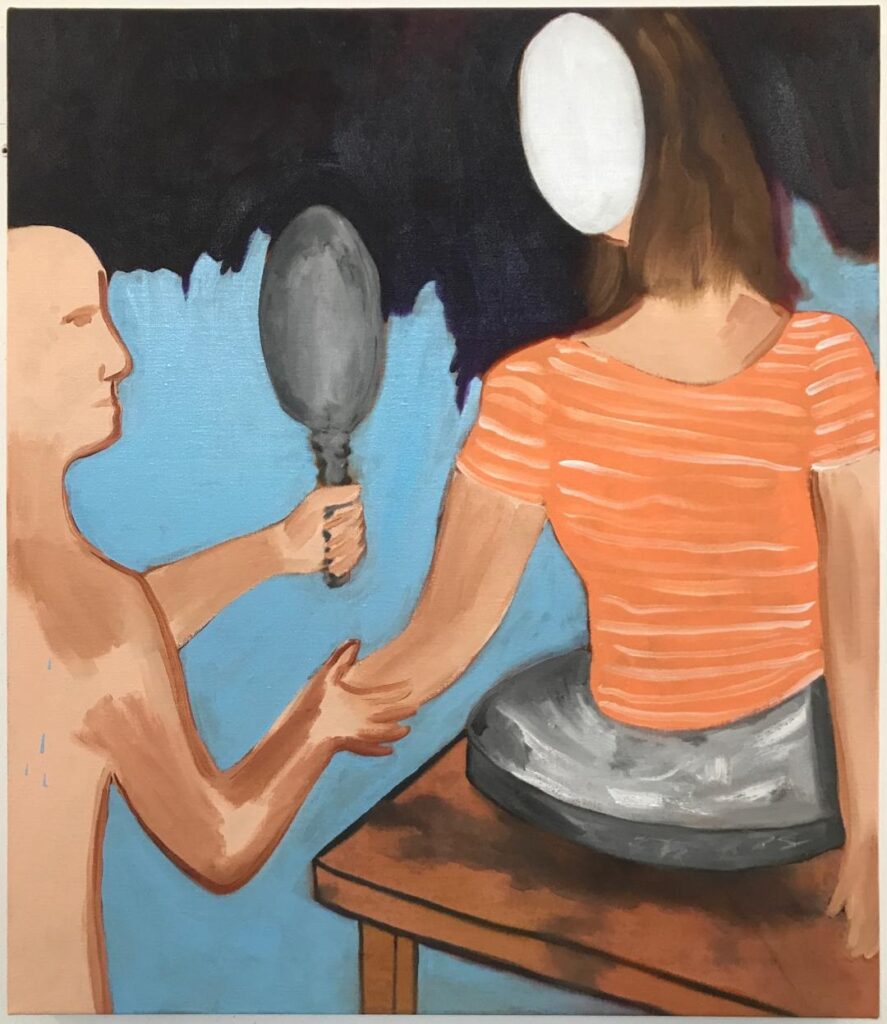Victoria Cantons is a contemporary painter and photographer who engages us through the visual expression her lived experiences as a LGBTQ artist. In my exploration and conversation with the artist, we explore her expressive works, figural paintings, motifs of flowers and photographs of friends.
Resources for this episode include Victoria Cantons website. You can follow Cantons on IG @victoriacantons and Twitter @victoriacantons.


Script: Episode 131: Victoria Cantons: Seeing Beyond the Visible
Let’s enter or journey into the practice and work of artist Victoria Cantons through her words before we dive into her work. She says in part, from her artist statement:
Through art “I consider the notion of what a woman is or can be and how people shape their beliefs. What we as individuals present to the world is multifaceted and not always visible, a continuous evolution in response to experience and in relationship to each other.”
Canton’s paintings, from this 50 year old, transgender woman are shaped by her multi-national, cultural and religious background. She was born an only child in London, mother was from Madrid and Catholic, father was French born to Russian Jew and Basque parents. Her work “always begin with questions and the sketchbook, though she often uses elements of photographs as source material, her own and sometimes found. She says, “I am seeking to translate what I am feeling in that time through painting it. Though many of the paintings could not exist without photography, it is not the origin of the image that is important. I am concerned with the emotional response triggered within and its potential for reinterpretation or translation.
Painting relates to moments that are to do with things that are beyond language, beyond logic, beyond gravity and sound and nature. As we will see, her imagery, the content, even the titles which are very compelling, the core of her work is centered on the human condition, gender, social identity informed by contemporary and western art history.
On Canton’s website, she posts images from her sketchbook, page by page and we can see some of those images and imaginings translated onto the canvas. Her paintings are expressive, the brushwork often visible. I am very drawn to her compositions, the way she focuses or hones in on, for example, a specific part of the body. In the painting “Ballad,” against a bright red background, we see a pair of crossed legs, seated on a partially viewed white chair. The emphasis of the full thighs leads our eyes to the daintiness of the sitter’s feet.
In the painting “A New Landmark,” painted in 2020, we see two nude figures, one is a male reclining on a bed, He appears to be sleeping, his right arm languidly falls to the side, fingers rest on the floor. In front of the bed, is a nude woman, she is posed in a relaxed manner, exposing her breasts and genitals. The color palette of the room is muted white, some blue seeps into the walls, floor is brown, except on the far right of the canvas there is a burst of bright pink flowers, perhaps poppies in a gold ornate frame. The male and the female are the same person—this is a self-portrait—we see the transition in Canton’s gender expressed in the figures. This work brings visibility to herself and the transgender community. The beauty is in the ordinariness of the bodies and the vibe of the blooming, vibrant flowers.
One work I found compelling is “Remember who you are and who you could be” from 2018. Two figures, one a nude male holds up a hand mirror towards the face of another figure. She appears to be a woman, long straight brown hair, orange striped shirt, her torso is situated in a large grey bowl atop a four legged brown table. The background is bright, vibrant blue. There is a swath of black paint atop some of the blue that drips in uneven waves across the canvas. What holds the viewer’s interest is the face of the woman in the orange shirt. There is no face, from the mirror what is reflected is an oval, white circle devoid of any facial features. The work is open to multiple interpretations—though again quoting from Cantons, “We are not just the clothed person we present to the world. We have many faces.”
Art that is produced by members of the LGBTQ community is often framed by the artist’s gender or sexuality. Labeling an artwork with its maker’s identity is a painful oversimplification of the artist and their art. And while many LGBTQ artists incorporate their lived experiences into their work, it is important to remember that their output should be treated as separate from their body and identity.
I believe even Canton would concur—she writes in her artist statement: “I would like to think that gender is not important when one is painting however I am aware of the male and female gaze and the feminist issues that are being debated globally. Ultimately there is a search for the poetic and an attempt to get it all on the level.”
This is a space I too am navigating within the discourse of identity. I think Canton positions us in a conversation we may not know—she makes visible her gender, her identity but also her exploration of her inner life. With that, please join me in a conversation with the artist Victoria Cantons.
